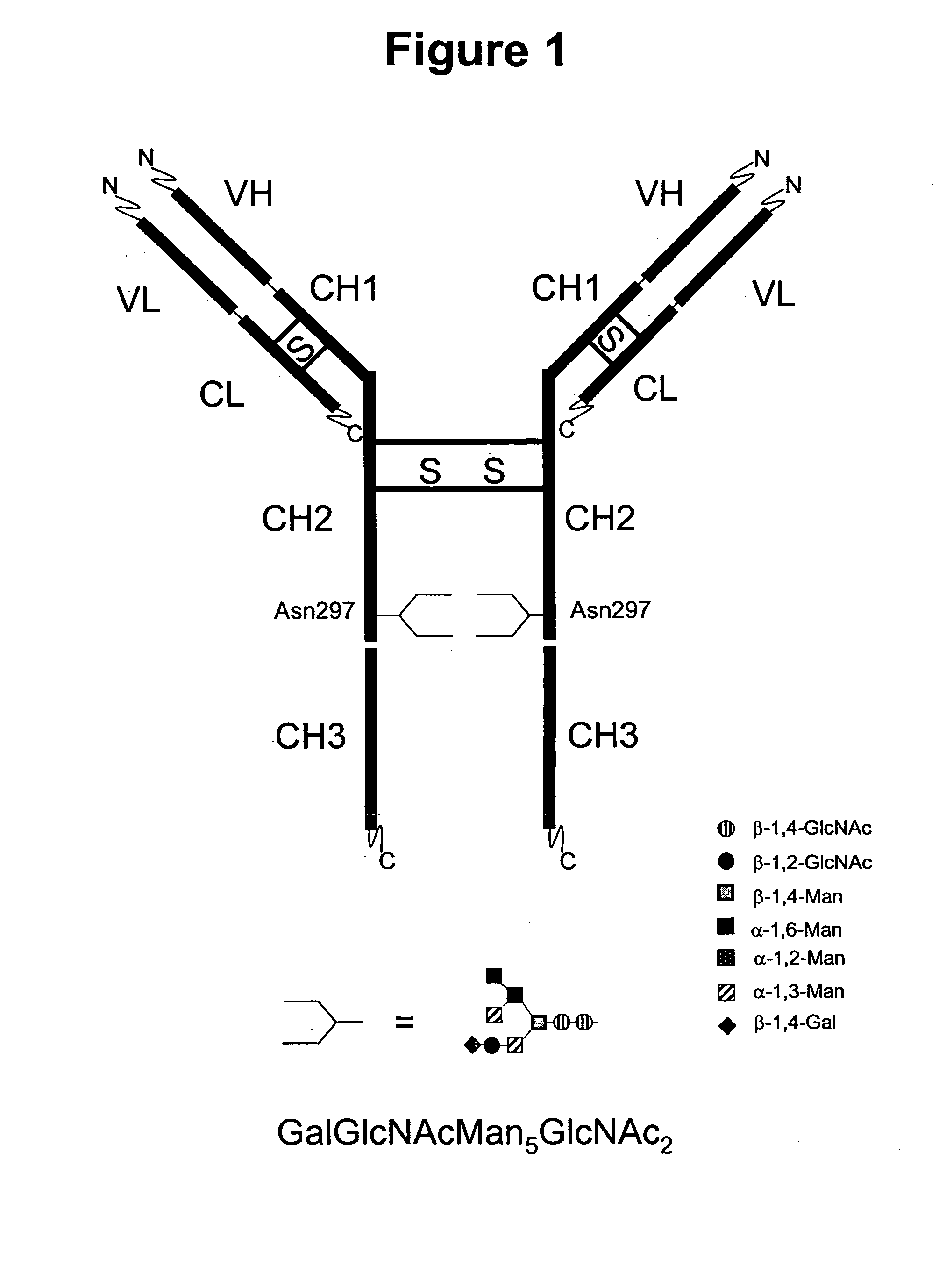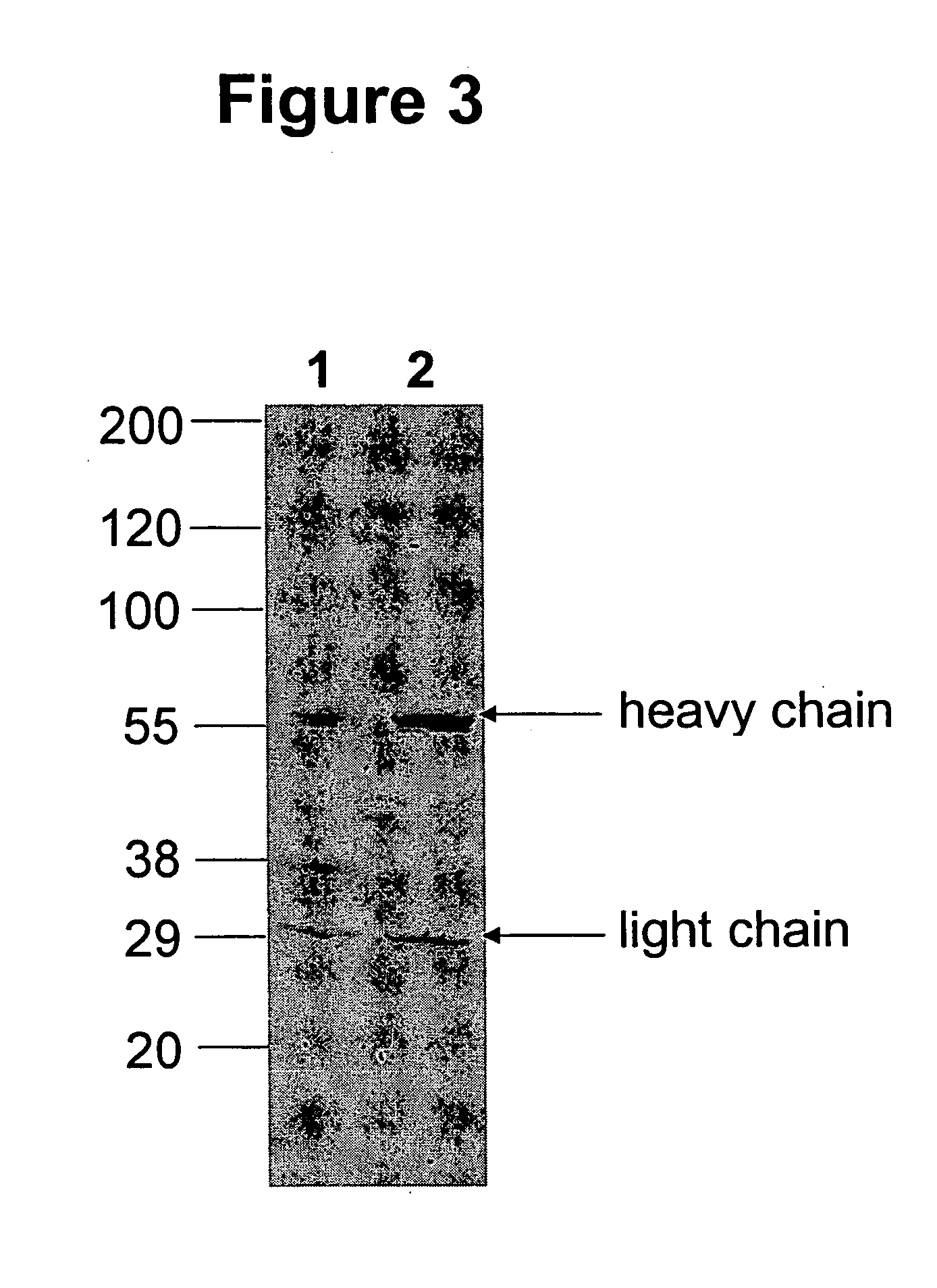Immunoglobulins comprising predominantly a GalGlcNAcMan5GLcNAc2 glycoform
a glycoprotein and immunoglobulin technology, applied in the field of immunoglobulin glycoprotein compositions, can solve the problems of low volumetric titers, heterogeneous glycoform populations of expressing proteins in mammalian cells, removal and destruction of complexes, etc., and achieve the effect of avoiding or minimizing adverse effects
- Summary
- Abstract
- Description
- Claims
- Application Information
AI Technical Summary
Benefits of technology
Problems solved by technology
Method used
Image
Examples
example 1
Cloning of DX-IG1 for Expression in P. pastoris
[0147] The light (L) and heavy (H) chains of DX-IgG1 (an anti-CD20 IgG1) consists of mouse variable regions and human constant regions. The light chain is disclosed as SEQ ID NO: 1 and heavy chain as SEQ ID NO: 2. The heavy and light chain sequences were synthesized using overlapping oligonucleotides purchased from Integrated DNA Technologies (IDT). For the light chain variable region, 15 overlapping oligonucleotides (SEQ ID NOs: 5-19) were purchased and annealed using Extaq (Takada) in a PCR reaction to produce the light chain variable region fragment having a 5′ MlyI site. This light chain variable fragment was then joined with the light chain constant region (SEQ ID NO: 3) (Gene Art, Toronto, Canada) by overlapping PCR using the 5′ MlyI primer CD20L / up (SEQ ID NO: 20), the 3′ variable / 5′ constant primer Lfusion RTVAAPS / up (SEQ ID NO: 21), the 3′ constant region primer Lfusion RTVAAPS / lp (SEQ ID NO: 22) and 3′ CD20L / p (SEQ ID NO: 23...
example 2
[0152] Transformation of IgG vectors into P. pastoris strain YAS385-1. The vector DNA is prepared by adding sodium acetate to a final concentration of 0.3 M. One hundred percent ice cold ethanol is then added to a final concentration of 70% to the DNA sample. The DNA is pelleted by centrifugation (12000 g×10 min) and washed twice with 70% ice cold ethanol. The DNA is dried and resuspended in 50 μl of 10 mM Tris, pH 8.0. A YAS385-1 yeast culture (Choi et al., 2003; Hamilton et al., 2003) to be transformed is prepared by expanding a smaller culture in BMGY (buffered minimal glycerol: 100 mM potassium phosphate, pH 6.0; 1.34% yeast nitrogen base; 4×10−5% biotin; 1% glycerol) to an O.D. of ˜2-6. The yeast cells are then made electrocompetent by washing 3 times in 1M sorbitol and resuspending in ˜1-2 mls 1M sorbitol. DNA (1-2 μg) is mixed with 100 μl of competent yeast and incubated on ice for 10 min. Yeast cells are then electroporated with a BTX Electrocell Manipulator 600 using the fo...
example 3
Purification of IgG1
[0155] Monoclonal antibodies were captured from the culture supernatant using a Streamline Protein A column. Antibodies were eluted in Tris-Glycine pH 3.5 and neutralized using 1M Tris pH 8.0. Further purification was carried out using hydrophobic interaction chromatography (HIC). The specific type of HIC column depends on the antibody. For the JC-IgG and the DX-IgG a phenyl sepharose column (can also use octyl sepharose) was used with 20 mM Tris (7.0), 1M (NH4)2SO4 buffer and eluted with a linear gradient buffer of 1M to 0M (NH4)2SO4. The antibody fractions from the phenyl sepharose column were pooled and exchanged into 50 mM NaOAc / Tris pH 5.2 buffer for final purification through a cation exchange (SP Sepharose Fast Flow) (GE Healthcare) column. Antibodies were eluted with a linear gradient using 50 mM Tris, 1M NaCl (pH 7.0).
[0156] Treatment of JC-IgG and DX-IgG from YAS385-1 with β-1,4 galactosyltransferase 5 mg of purified IgG (JC-IgG or DX-IgG) was buffer...
PUM
| Property | Measurement | Unit |
|---|---|---|
| Tm | aaaaa | aaaaa |
| temperatures | aaaaa | aaaaa |
| dissociation constant | aaaaa | aaaaa |
Abstract
Description
Claims
Application Information
 Login to View More
Login to View More - R&D
- Intellectual Property
- Life Sciences
- Materials
- Tech Scout
- Unparalleled Data Quality
- Higher Quality Content
- 60% Fewer Hallucinations
Browse by: Latest US Patents, China's latest patents, Technical Efficacy Thesaurus, Application Domain, Technology Topic, Popular Technical Reports.
© 2025 PatSnap. All rights reserved.Legal|Privacy policy|Modern Slavery Act Transparency Statement|Sitemap|About US| Contact US: help@patsnap.com



